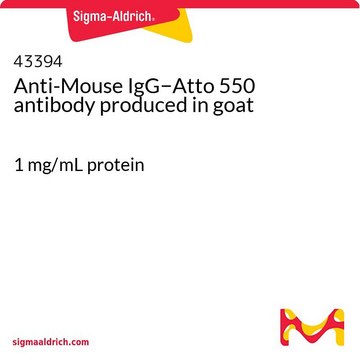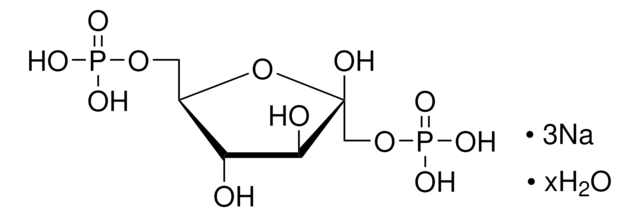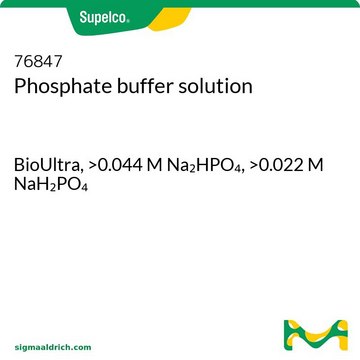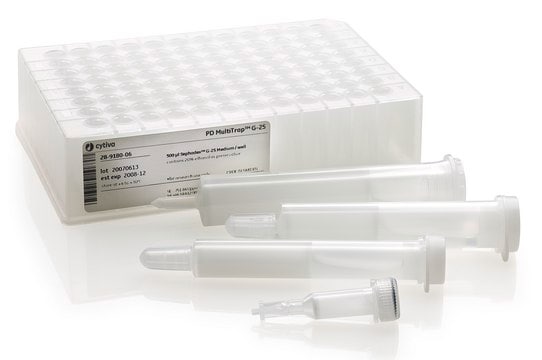51146
Atto 550 Protein Labeling Kit
BioReagent, suitable for fluorescence
Sign Into View Organizational & Contract Pricing
All Photos(1)
About This Item
UNSPSC Code:
12352200
NACRES:
NA.32
Recommended Products
product line
BioReagent
Quality Level
manufacturer/tradename
ATTO-TEC GmbH
fluorescence
λex 544 nm; λem 576 nm in 0.1 M phosphate buffer, pH 7.0 (recommended)
suitability
suitable for fluorescence
storage temp.
2-8°C
Looking for similar products? Visit Product Comparison Guide
Related Categories
General description
This kit contains sufficient amounts of reactive dye, buffers and protein purification sets for performing five labeling reactions (1 mg protein each) and for the subsequent purification of the labeled protein.
Application
Atto fluorescent labels are designed for high sensitivity applications, including single molecule detection. Atto labels have rigid structures that do not show any cis-trans-isomerization. Thus these labels display exceptional intensity with minimal spectral shift on conjugation. Atto 550, which is similar to Cy3, may be useful in applications such as fluorescence resonance energy transfer (FRET) and as a tag for molecules such as secondary antibodies. Atto 550 Protein Labeling Kit contains Atto 550 succinimidyl ester which enables conjugation of Atto 550 to the primary amino groups of the proteins and other molecules.
Legal Information
This product is for Research use only. In case of intended commercialization, please contact the IP-holder (ATTO-TEC GmbH, Germany) for licensing.
Not finding the right product?
Try our Product Selector Tool.
Storage Class Code
10 - Combustible liquids
WGK
WGK 3
Choose from one of the most recent versions:
Already Own This Product?
Find documentation for the products that you have recently purchased in the Document Library.
Customers Also Viewed
Smart-aggregation imaging for single molecule localization with SPAD cameras.
Gyongy, I.; et al.
arXiv (2016)
Andrew H J Salmon et al.
Journal of the American Society of Nephrology : JASN, 23(8), 1339-1350 (2012-07-17)
Patients with albuminuria and CKD frequently have vascular dysfunction but the underlying mechanisms remain unclear. Because the endothelial surface layer, a meshwork of surface-bound and loosely adherent glycosaminoglycans and proteoglycans, modulates vascular function, its loss could contribute to both renal
Antibody transfection into neurons as a tool to study disease pathogenesis.
Douglas JN, Gardner LA, et al.
Journal of Visualized Experiments, 26, 4154-4154 (2012)
Sandeep Kumar Vashist
Analytical biochemistry, 421(1), 336-338 (2011-11-19)
A surface plasmon resonance (SPR)-based procedure was developed to determine the effect of antibody modifications on its biomolecular binding behavior. Mouse immunoglobulin G (IgG) was immobilized on a protein A-functionalized gold-coated SPR chip. Goat anti-mouse IgG and its various commercially
Michel Frigoli et al.
Chemistry (Weinheim an der Bergstrasse, Germany), 15(33), 8319-8330 (2009-07-04)
Core-shell type dual fluorescent nanoparticles (NPs) in the 16 nm diameter range with a selective ligand (cyclam) attached to the surface and two fluorophores--9,10-diphenyl-anthracene (donor, D) and pyrromethene PM 567 (acceptor, A)--embedded within the polymer core were synthesized and their
Articles
Sigma® offers protein labeling kits based on two types of fluorescent dyes, the Atto dyes and the Tracy dyes.
Our team of scientists has experience in all areas of research including Life Science, Material Science, Chemical Synthesis, Chromatography, Analytical and many others.
Contact Technical Service




